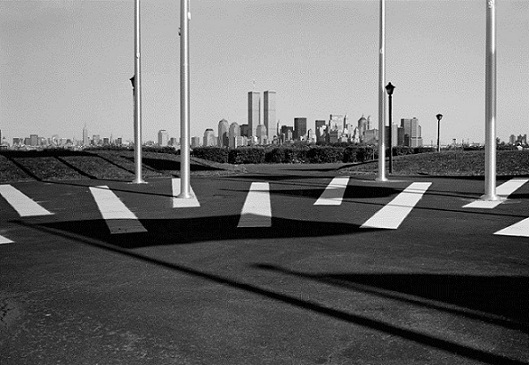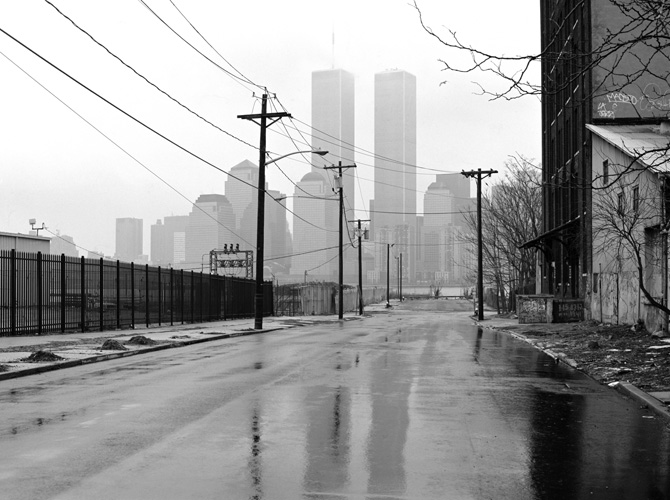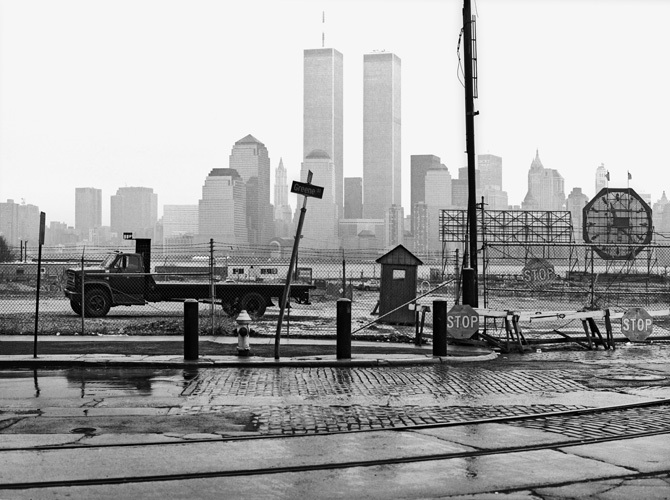藝評
Down (The World Trade Center and Gretchen So's photographs)
約翰百德 (John BATTEN)
at 7:18pm on 8th September 2011




Captions:
1. Liberty State Park, Jersey City, NJ 07305, 1993.
2. Comfort Rd, Governors Island, NY 10004, 1992.
3. Essex/Greene St, Jersey City, NJ 07302, 1991.
4. Grand/Greene St, Jersey City, NJ 07302, 1991.
Photo courtesy of the artist Gretchen So. A full selection of her World Trade Center photographs is at:
http://www.gretchenso.com/new-york-10048.html
(原文以英文發表,評論紐約世貿大樓及《紐約郵政編碼10048: 九十年代初的世貿大樓》攝影展。)
Down
by John Batten
I have never visited New York. Nor, of course, have billions of other people in the world.
I certainly can’t speak for them, but I suspect any person exposed to American culture and its exports would share some of the following thoughts.
My impression of New York City and its buildings have been entirely constructed in my mind; fuzzy impressions from books, films, television and photographs. The Manhattan skyline: a mountain range of high-rises. The Statue of Liberty: adrift on an island. Abstract Expressionism/New York School: de Kooning; Gaston; Pollack, Motherwell et al. The city’s great museums: many, but the Guggenheim’s spiral is the only interior I can recall. Parks: there is Central Park, but any others? Of course, Henry James’ Washington Square: its park.
From over here, the World Trade Center has an unremarkable, generic name. How many World Trade Centers/Centres are there in the world? Hong Kong’s own World Trade Centre in Causeway Bay opened in the 1970s, but in 2006 became an absurd acronym, “wtc more”. Like most sensible people, I still refer to the building as the World Trade Centre.
I am of my time. The world’s tallest building was always New York’s Empire State Building, or was, until the World Trade Centre’s North Tower was constructed – not that this fact influenced my comparison of high and highest. I have always compared all tall buildings then and now, “as tall as the Empire State Building”. My formative years did not allow the phrase to advance further to “as tall as the Twin Towers” or “as tall as the Petronas (Kuala Lumpur) Towers”. My impressions anchor me in my time; likewise to those of their time in the near past, that could only think of tall as in tall as the Eiffel Tower.
The Empire State Building enters this World Trade Center story as more than just another tall building. In thick fog on 28 July 1945, a US Army Air Corps B-25 Mitchell Bomber-turned-transporter became completely disorientated over Manhattan while flying en route to nearby Newark, New Jersey and crashed into the 79th floor of the fog-covered Empire State Building. One of the plane’s engines careened through the side of the building and landed on an adjacent high-rise roof; the plane’s fuselage damaged elevator shafts and cables and the ruptured fuel tank spewed fuel inside and down the sides of the building. The three men aboard the plane and eleven people working in the building died and fire spread on the 79th floor. Remarkably, the building superstructure was not compromised and the fire was contained within forty minutes and, supposedly, is the only fire at such a height to be successfully extinguished.
After its domestically controversial involvement in World War I, the US introduced a self-imposed period of isolation in world affairs. Historians have, however, questioned the actual strength and truth of this isolationist period, but it is without argument that US popular culture spread worldwide in the 1920s and 1930s through the emerging dominance of Hollywood movies, music and belief in the guaranteed success of any new emigrant arriving in the USA. Then, a few years later, American military strength was undeniable during World War II. In the 1950s and 1960s, American television series spread US values and its rose-tinted depiction of Middle America alongside the free movement of Elvis Presley’s rock ‘n roll and a rising libertarianism.
YouTube replays much of that era: the discussion accompanying a film clip of the 5th Dimension singing their 1967 chart hit, Up, Up and Away is revealing of the period and life in sprawling American suburbia:
“I remember as a small child in the 60's watching the Fifth Dimension, thinking they made adulthood look so cool...I couldn't wait. LOL, if only I knew.”
“I had those same thoughts as a child in the 60's. And when I grew up I was going to live in a split level in the suburbs with a wonderful husband and kids like Samantha on Bewitched and give fantastic dinner parties with music by the 5th Dimension. LOL, what I had to learn.”
“The sixties and early seventies were so amazing, aside from all the wars and assassinations. Damn maybe not so amazing............. But musically amazing.”
“I was like two or three at the time...but I remember commercials on TV with this great group...was it Jello pudding? I wish someone knew....this music I would hear as I took naps...”
“Yes, it was for Jello Pudding - the 5th were dancing on top of a huge pudding box, and it's available on YouTube.”
“Well it's funny you should feel that way but back in the 60's when this came out it was actually a pretty hip song because people thought the Fifth was singing about being high!” (1)
In chorus, outside on the streets, cries of “US imperialism!” – both inside and out of the USA – increased as the mess of the Vietnam War unfolded and cracks in its own political system were exposed during the Watergate hearings and its final denouement: the resignation of Richard Nixon.
We all think we know the USA, but George W. Bush’s plaintive question, “Why do they hate us?” and the notion that others believed “they deserved it”, indicate otherwise. A growing distaste in some places towards the US, its political and cultural values and its untidy worldwide foreign policy, especially as perceived towards the Middle East, was little understood or seriously appreciated – certainly, by many Americans – until the World Trade Center in New York was targeted and destroyed in a horrific enhanced-replay of the earlier 1945 plane collision, on live television, on 11 September 2001.
As a young photography student in New York during the 1990s, Gretchen So noticed that the World Trade Center towers would uncannily appear in many of her photographs. A dedicated portfolio was undertaken and the towers photographed from different places around New York, looking back towards Manhattan, from New Jersey and Brooklyn, always with the World Trade Center peering on the skyline. Gretchen recalls that she specifically photographed the towers, as they were a “very powerful symbol of democracy, opportunity, and success” and “as an artist I saw them not so much as an engineering marvel, but rather as an omnipresent witness of modern life in cosmopolitan New York, the worldliest of cities.”
These same black-and-white photographs now straddle uneasy psychological territory when viewed, post-9/11. Through their depiction, the towers’ physical presence taunts history by not being there. The photographs are actually symbolically richer than when they were photographed, covering a range of emotions and memories of both a pre-9/11 and post-9/11 world – and many of us mark changed everyday (often annoying or bureaucratic) routines, such as checking in at an airport, with the phrases “before” and “after 9/11”. These photographs are the equivalent of a graphic/photographic bookmark for many of us who do remember the before and know the after.
Gretchen’s exhibition of these photographs is opportune. They are and will always be a documentary record and landscaped depiction of New York City. However, over time, the historical power of events does wane – even if their immediate post-event consequences are played out for years. The wars in Iraq and Afghanistan will ensure 9/11 is a date to remember. But people’s actual memory of before and after the date of 11 September 2001 is crucial for these photographs to retain their power. We, of this generation, are emotionally linked to “9/11” and Gretchen’s photographs could be a ‘fetish’; a talisman to be quietly brought out and considered in moments of fear, trepidation and as a memory jolt.
Alternatively, we could watch television, and its period dramas, such as 'Mad Men' or the possibly appropriate 'Pan Am' – a new drama series filmed in New York about the iconic US airline Pan American World Airways, whose fifty year domination of the skies eventually ended; and, on entering bankruptcy in 1991, went down.
Notes:
(1) YouTube discussion on the 5th Dimension singing 'Up, Up and Away' on the 1968 Grammy Awards – see internet link: http://www.youtube.com/watch?v=aoSocikOpHU&feature=related
Exhibition: NY 10048: The World Trade Center in Early 1990s
Date: 2.9.2011 – 15.9.2011
Venue: The Anita Chan Lai-ling Gallery, The Fringe Club
http://www.hkfringe.com.hk/va_en.html#1
Exhibition: NY 10048: The World Trade Center in Early 1990s
Date: 2.9.2011 – 30.9.2011
Venue: Main Bar, The Foreign Correspondents' Club
http://www.fcchk.org/fccweb/news.html?id=CA26BD436A7901440D37E55344E51815
1. Liberty State Park, Jersey City, NJ 07305, 1993.
2. Comfort Rd, Governors Island, NY 10004, 1992.
3. Essex/Greene St, Jersey City, NJ 07302, 1991.
4. Grand/Greene St, Jersey City, NJ 07302, 1991.
Photo courtesy of the artist Gretchen So. A full selection of her World Trade Center photographs is at:
http://www.gretchenso.com/new-york-10048.html
(原文以英文發表,評論紐約世貿大樓及《紐約郵政編碼10048: 九十年代初的世貿大樓》攝影展。)
Down
by John Batten
I have never visited New York. Nor, of course, have billions of other people in the world.
I certainly can’t speak for them, but I suspect any person exposed to American culture and its exports would share some of the following thoughts.
My impression of New York City and its buildings have been entirely constructed in my mind; fuzzy impressions from books, films, television and photographs. The Manhattan skyline: a mountain range of high-rises. The Statue of Liberty: adrift on an island. Abstract Expressionism/New York School: de Kooning; Gaston; Pollack, Motherwell et al. The city’s great museums: many, but the Guggenheim’s spiral is the only interior I can recall. Parks: there is Central Park, but any others? Of course, Henry James’ Washington Square: its park.
From over here, the World Trade Center has an unremarkable, generic name. How many World Trade Centers/Centres are there in the world? Hong Kong’s own World Trade Centre in Causeway Bay opened in the 1970s, but in 2006 became an absurd acronym, “wtc more”. Like most sensible people, I still refer to the building as the World Trade Centre.
I am of my time. The world’s tallest building was always New York’s Empire State Building, or was, until the World Trade Centre’s North Tower was constructed – not that this fact influenced my comparison of high and highest. I have always compared all tall buildings then and now, “as tall as the Empire State Building”. My formative years did not allow the phrase to advance further to “as tall as the Twin Towers” or “as tall as the Petronas (Kuala Lumpur) Towers”. My impressions anchor me in my time; likewise to those of their time in the near past, that could only think of tall as in tall as the Eiffel Tower.
The Empire State Building enters this World Trade Center story as more than just another tall building. In thick fog on 28 July 1945, a US Army Air Corps B-25 Mitchell Bomber-turned-transporter became completely disorientated over Manhattan while flying en route to nearby Newark, New Jersey and crashed into the 79th floor of the fog-covered Empire State Building. One of the plane’s engines careened through the side of the building and landed on an adjacent high-rise roof; the plane’s fuselage damaged elevator shafts and cables and the ruptured fuel tank spewed fuel inside and down the sides of the building. The three men aboard the plane and eleven people working in the building died and fire spread on the 79th floor. Remarkably, the building superstructure was not compromised and the fire was contained within forty minutes and, supposedly, is the only fire at such a height to be successfully extinguished.
After its domestically controversial involvement in World War I, the US introduced a self-imposed period of isolation in world affairs. Historians have, however, questioned the actual strength and truth of this isolationist period, but it is without argument that US popular culture spread worldwide in the 1920s and 1930s through the emerging dominance of Hollywood movies, music and belief in the guaranteed success of any new emigrant arriving in the USA. Then, a few years later, American military strength was undeniable during World War II. In the 1950s and 1960s, American television series spread US values and its rose-tinted depiction of Middle America alongside the free movement of Elvis Presley’s rock ‘n roll and a rising libertarianism.
YouTube replays much of that era: the discussion accompanying a film clip of the 5th Dimension singing their 1967 chart hit, Up, Up and Away is revealing of the period and life in sprawling American suburbia:
“I remember as a small child in the 60's watching the Fifth Dimension, thinking they made adulthood look so cool...I couldn't wait. LOL, if only I knew.”
“I had those same thoughts as a child in the 60's. And when I grew up I was going to live in a split level in the suburbs with a wonderful husband and kids like Samantha on Bewitched and give fantastic dinner parties with music by the 5th Dimension. LOL, what I had to learn.”
“The sixties and early seventies were so amazing, aside from all the wars and assassinations. Damn maybe not so amazing............. But musically amazing.”
“I was like two or three at the time...but I remember commercials on TV with this great group...was it Jello pudding? I wish someone knew....this music I would hear as I took naps...”
“Yes, it was for Jello Pudding - the 5th were dancing on top of a huge pudding box, and it's available on YouTube.”
“Well it's funny you should feel that way but back in the 60's when this came out it was actually a pretty hip song because people thought the Fifth was singing about being high!” (1)
In chorus, outside on the streets, cries of “US imperialism!” – both inside and out of the USA – increased as the mess of the Vietnam War unfolded and cracks in its own political system were exposed during the Watergate hearings and its final denouement: the resignation of Richard Nixon.
We all think we know the USA, but George W. Bush’s plaintive question, “Why do they hate us?” and the notion that others believed “they deserved it”, indicate otherwise. A growing distaste in some places towards the US, its political and cultural values and its untidy worldwide foreign policy, especially as perceived towards the Middle East, was little understood or seriously appreciated – certainly, by many Americans – until the World Trade Center in New York was targeted and destroyed in a horrific enhanced-replay of the earlier 1945 plane collision, on live television, on 11 September 2001.
As a young photography student in New York during the 1990s, Gretchen So noticed that the World Trade Center towers would uncannily appear in many of her photographs. A dedicated portfolio was undertaken and the towers photographed from different places around New York, looking back towards Manhattan, from New Jersey and Brooklyn, always with the World Trade Center peering on the skyline. Gretchen recalls that she specifically photographed the towers, as they were a “very powerful symbol of democracy, opportunity, and success” and “as an artist I saw them not so much as an engineering marvel, but rather as an omnipresent witness of modern life in cosmopolitan New York, the worldliest of cities.”
These same black-and-white photographs now straddle uneasy psychological territory when viewed, post-9/11. Through their depiction, the towers’ physical presence taunts history by not being there. The photographs are actually symbolically richer than when they were photographed, covering a range of emotions and memories of both a pre-9/11 and post-9/11 world – and many of us mark changed everyday (often annoying or bureaucratic) routines, such as checking in at an airport, with the phrases “before” and “after 9/11”. These photographs are the equivalent of a graphic/photographic bookmark for many of us who do remember the before and know the after.
Gretchen’s exhibition of these photographs is opportune. They are and will always be a documentary record and landscaped depiction of New York City. However, over time, the historical power of events does wane – even if their immediate post-event consequences are played out for years. The wars in Iraq and Afghanistan will ensure 9/11 is a date to remember. But people’s actual memory of before and after the date of 11 September 2001 is crucial for these photographs to retain their power. We, of this generation, are emotionally linked to “9/11” and Gretchen’s photographs could be a ‘fetish’; a talisman to be quietly brought out and considered in moments of fear, trepidation and as a memory jolt.
Alternatively, we could watch television, and its period dramas, such as 'Mad Men' or the possibly appropriate 'Pan Am' – a new drama series filmed in New York about the iconic US airline Pan American World Airways, whose fifty year domination of the skies eventually ended; and, on entering bankruptcy in 1991, went down.
Notes:
(1) YouTube discussion on the 5th Dimension singing 'Up, Up and Away' on the 1968 Grammy Awards – see internet link: http://www.youtube.com/watch?v=aoSocikOpHU&feature=related
Exhibition: NY 10048: The World Trade Center in Early 1990s
Date: 2.9.2011 – 15.9.2011
Venue: The Anita Chan Lai-ling Gallery, The Fringe Club
http://www.hkfringe.com.hk/va_en.html#1
Exhibition: NY 10048: The World Trade Center in Early 1990s
Date: 2.9.2011 – 30.9.2011
Venue: Main Bar, The Foreign Correspondents' Club
http://www.fcchk.org/fccweb/news.html?id=CA26BD436A7901440D37E55344E51815
